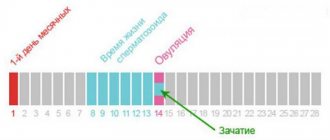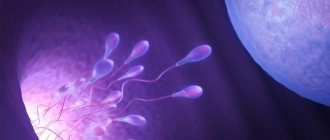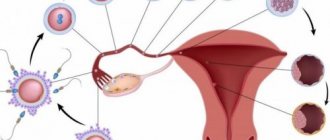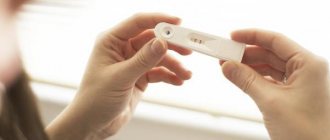Photo: UGC The issue of female fertility is one of the most pressing in the modern world. Some women can easily get pregnant and carry a child to term, but for others it is a real problem. If you fall into the latter category, then before you despair and become despondent, take advantage of useful information from fertility doctors. In the article you will find a description of methods that will help you determine on which days you can get pregnant without effort, and on which days your chances are low.
The percentage of visits to fertility specialists by young couples who cannot become parents naturally has recently increased sharply. This occurs due to processes of decreased fertility (in translation - 'fertility') in men and women, which is caused by environmental, social problems, as well as health conditions.
Online calculation of ovulation using a calculator
To calculate the day of ovulation online, you need to enter the date of your last menstruation, its duration, and the duration of the cycle into the form provided (it is calculated from the 1st day of menstruation and ends with the first day of the next menstruation). After all the data has been entered, click the calculate button. As a result, a woman will see in her personal calendar the day of ovulation, as well as those dates when the probability of fertilization of the egg released from the ovary is highest.
Sexual intercourse should occur before and after ovulation every two days. Experts consider this frequency to be optimal for conception. If intimacy occurs more often, the ability of sperm to fertilize an egg decreases. Using the ovulation calendar, you can calculate the most favorable days for conceiving male and female babies. The displayed dates will be highlighted in a specific color.
Estimated ovulation date:
Favorable period for conception:
- The beginning of the next cycle
- Estimated date of ovulation
- Favorable days for conception
- Safe days
Other calculators
Calculate gestational age
Calculate by week
Calculate due date
It should be understood that ovulation does not last long, so the period of possibility of conceiving a child is very short.
Doctors strongly recommend that every woman keep a menstrual calendar, which allows her to control her own cycle. This will allow you to calculate the day of your next ovulation with maximum accuracy. The fact is that for a woman, the timing of the release of an egg from the ovary varies from month to month.
How to calculate safe days so as not to get pregnant?
There are three techniques for calculating days unsuitable for conception:
— by calendar/using the application
The method is based on the use of a menstrual cycle calculator. You can use it online or download it to your smartphone. This is a very convenient application for those who monitor their own health. In the program, you must indicate the average cycle length, as well as the duration of menstrual bleeding. As a result of simple calculations, the program will give you the most favorable and unfavorable days for conception.
Reference! The best apps for tracking your menstrual cycle are Flo, Clue, Eve, Pink Pad and Period Tracker.
More on the topic
How to determine the day of conception of a child?
Features of the menstrual cycle and its relationship with pregnancy
Probability of getting pregnant on different days of the cycle
Probability of getting pregnant on the day of ovulation
How to determine the day of ovulation and which method is the most accurate?
- using temperature measurements
Measuring basal temperature is most often used to detect ovulation. This is a long and painstaking process that takes three to four cycles.
To do this, you need to measure your basal body temperature every day at the same time using a rectal thermometer and record the data obtained in a special calendar. To obtain the most reliable information, adhere to the following rules:
- Measure your temperature in the morning, immediately after waking up - without getting out of bed.
- Write down the data received every day, connecting the numbers with a line. This way you will get a line graph with a depression (decrease in temperature) approximately in the center.
- Build the next month’s schedule on top of the previous one, and so on for 3-4 cycles.
Check the data received: in each of the graphs there is a notch on day 1, and these “holes” approximately coincide with each other - this day is ovulation. That is, the most favorable day for conception.
Note! Despite the effectiveness of the method of measuring basal temperature, the data may be distorted by a current illness or taking hormonal medications.
- using the cervical method
This is the scientific name for a technique that involves tracking vaginal mucus. Depending on the quantity and quality of discharge, you can calculate the days when the probability of conception is greatest, or, conversely, extremely low.
- Scanty discharge : observed from the 18th day of the cycle to the first day of menstruation, provided that the girl does not have gynecological diseases.
- Thick, stringy mucus : secreted from the 10th to 17th day of menstruation, and indicates the onset of ovulation.
Methods for calculating the day of ovulation
Currently available methods for determining the day of ovulation:
- By regularly measuring basal body temperature. In order for the indicators to be as accurate as possible, measurements must be taken at 7 a.m., before getting out of bed.
- Using an ovulation test, which requires a sample of urine. This test is easy to perform at home. The principle of operation of such a device is identical to the principle of operation of a pregnancy test (it determines the level of luteinizing hormone in urine). However, it should be performed daily.
- Using an ovulation calendar.
- By submitting a mucus test for examination (the sample is taken from the cervical canal).
- Using ultrasound in the doctor's office. You will need to undergo an ultrasound once every 2-3 days. This will allow the doctor to determine the date of the next ovulation as accurately as possible.
As for the sensations that a woman experiences, during ovulation she may experience mild nagging pain in the lower abdomen. In parallel, there is an increase in the amount of vaginal discharge (clear mucus).
Main signs of ovulation
In some cases, women have irregular cycles and find it more difficult to determine the right days to conceive. Then you need to know other signs indicating the onset of ovulation.
Cervical changes
If cervical mucus is similar to egg whites in consistency and appearance, then ovulation is either occurring or approaching. This fluid may look different for every woman, but ovulation is usually the day with the most viscous fluid.
Change in body temperature
Most women experience a constant basal body temperature (BBT) throughout the menstrual cycle. It may decrease slightly the day before ovulation, but the most important change is the significant increase in BBT that begins the day after ovulation and continues. To determine favorable days for conception, you need to measure your temperature regularly and keep a chart for at least 3 menstrual cycles.
Firmness of the cervix or changes in its position
During ovulation, the cervix undergoes many changes. You may notice that it is wet, open, soft, or raised. It is necessary to pay attention to examining the cervix over several cycles in order to be able to distinguish its condition during ovulation and other days.
Secondary signs
Secondary signs do not necessarily occur in all women, but can also help determine favorable days for conception. Some symptoms include increased sex drive, bloating, breast tenderness, mild pain or cramping in the pelvic area, and increased perception of taste or smell.
Use tests to determine ovulation
You can buy ovulation tests at a pharmacy or store. They will be able to warn about its occurrence 12-24 hours in advance. The principle of operation is based on measuring the level of luteinizing hormone (LH), the amount of which reaches its peak just before the onset of ovulation. You just need urine for a test to determine when you are ovulating. This is not the best way to determine the best days to conceive, since it works at the very end of the fertile window, but it is quick and simple.
( 2 ratings, average: 3.50 out of 5)
Why do you need to calculate the day of ovulation?
If a woman is of reproductive age, then knowing on what day she will ovulate will allow her to either conceive a long-awaited child or protect herself from an unwanted pregnancy. In the second case, a woman will be able to reliably protect herself during sexual intercourse using certain methods of contraception. It is important to understand that when the cycle is unstable, abstaining from intimate life during ovulation is not a reliable method of contraception.
Although it is very easy to calculate the date of ovulation using a calendar, this method does not guarantee 100% protection against unwanted pregnancy.
Chance of getting pregnant
Fertilization of the egg occurs if there was unprotected sexual intercourse and ovulation occurred in the current month. When planning a pregnancy, a woman should initially visit a gynecologist, undergo an examination and make sure that there are no health problems. Before taking it, you need to count your cycle and remember the date of the last menstruation. A 28-day cycle is considered ideal. High probability of pregnancy is especially high on the 14th day.
On what days of the cycle can you get pregnant?
Despite birth control methods and condoms, any day of the cycle is favorable for conception. The fertile period begins five days before ovulation - the maturation of the egg. This means that hormonal changes have begun in the cervical mucus. It creates favorable conditions for sperm, and the expansion of the uterine os facilitates the penetration of sperm into the egg.
Chances of getting pregnant during your period
On what days can you get pregnant? On all days. For example, in case of hormonal imbalance or prolonged nervous tension, the egg matures until the middle of the menstrual cycle or does not mature at all. So if you are wondering what the probability of getting pregnant during your period is, then it is very high, especially in the last days. Heavy bleeding in the first menstrual days creates an unfavorable atmosphere for sperm, but with long, protracted menstruation, the risk of conceiving a baby increases.
Chances of getting pregnant after menstruation
Most girls believe that it is impossible to get pregnant after menstruation. Two days after the regulation are characterized by a low chance of pregnancy. However, it is worth considering that it is not zero. What is the probability of getting pregnant immediately after your period? In theory, the female body works by the clock, but in practice there is no way to accurately calculate how many days after menstruation you can get pregnant.
Is it possible to get pregnant a few days before your period?
When menstruation occurs, this does not mean that a woman cannot become pregnant. Women with a stable menstrual cycle are just as likely to become mothers as those with an irregular cycle. The chances of conceiving a child are different on certain days of the cycle. The best time to get pregnant is a week before your period. The days of the cycle can be divided into 4 phases:
- With follicular, the maturation of the follicle begins.
- Ovulatory accompanies the release of an egg.
- During the luteal phase, a change in hormonal levels occurs for conception.
- End: desquamation - the egg is released with the endometrium.
Ovulation date and gender of the unborn child
Scientists from the National Institute of Environmental Health Sciences (North Carolina) established an interesting fact during their research. It turns out that the time of conception in relation to the time of release of the egg from the ovary affects the gender of the unborn child. So, whether a woman will give birth to a girl or a boy depends on which sperm fertilized the egg: a sperm with a Y chromosome (a boy will be conceived) or a sperm with an X chromosome (a girl will be conceived).
So, scientists were able to find out that “female” sperm have less mobility, but are at the same time as hardy as possible, and sperm that lead to the conception of boys are more mobile, but are very sensitive to various external factors. Therefore, when intimacy occurs long before ovulation begins, the likelihood of having a girl is high. If sexual intercourse occurs on the day of ovulation or after it, then most likely a boy will be born.
When can you get pregnant after taking birth control pills?
Doctors recommend stopping birth control 9 weeks before conception occurs. It is during this period of time that the female reproductive system will be restored to normal. Below are examples of when you can get pregnant after taking birth control pills:
- Regulon . It is necessary to plan conception after using such an oral contraceptive only after 3 months. It is during this period that the woman’s body will completely remove the accumulated hormonal components.
- Jess and Yarina . These drugs, as in the previous case, should be discontinued no earlier than 3 months. Pregnancy can occur either immediately or 12 months after stopping the pills. Its onset is influenced by the duration of use of contraceptives by Jess and Yarina. The longer a woman takes such drugs, the longer she will have to wait for pregnancy to appear.
- Novinet . After discontinuation of this drug, you may not need to take breaks before conception. This is due to the amount of hormones in the product, which is several times different from other tablets. The concentration of such substances in Novinet is much lower.
It should be remembered that refusing contraception cannot guarantee an easy and quick pregnancy. This is influenced by the duration of use of the products, past illnesses, health status and age of the woman.
Determining ovulation by the nature of cervical mucus
During the monthly cycle, the nature of the mucus secreted by the cervix changes several times. After menstruation, this mucus is practically imperceptible, there is little of it and it is unsuitable for the life of sperm. Closer to the time of ovulation, it becomes thicker and more viscous. Favorable dates for pregnancy - fertile - dates can be determined by the mucus, which in its consistency resembles egg yolk - it is transparent and easily stretches between the fingers. It is this mucus that facilitates the movement of sperm along the woman’s reproductive tract to the egg. As soon as ovulation has passed, cervical mucus changes character again - it thickens and acquires a white or yellowish tint. Thus, by carefully observing herself, a woman can calculate the most favorable dates for pregnancy. For the greatest accuracy of the method, you should pay attention to the nature of the mucus several times a day; it is better to record the data in a special plate. It is worth considering that the method is unlikely to work when a woman uses vaginal medications for treatment or contraception.











